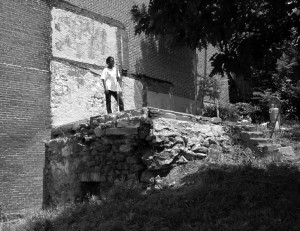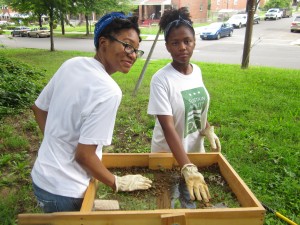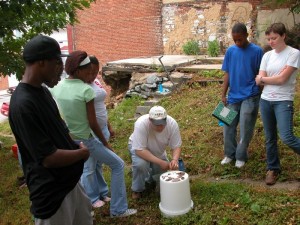Pulling back the layers: Participatory and community-based archeology
01 August 2014 – David Gadsby and Teresa Moyer
community history, The Public Historian, pulling back the curtain, archeology, National Park Service
Editor’s Note: In “What I’ve Learned Along the Way: A Public Historian’s Intellectual Odyssey,” outgoing NCPH President Bob Weyeneth issued a call to action to public historians to include the public more fully in our work by “pulling back the curtain” on our interpretive process—how we choose the stories we tell. In this series of posts, we’ve invited several public historians to reflect on projects that do exactly that, assessing their successes and examining the challenges we face when we let the public in through the door usually reserved for staff.
Early on a July morning, as the sun rises above the trees that line the eastern half of our urban dig site, the crew prepares for work. They use modified milk containers to bail the rain of last night’s thunderstorm from the plastic-lined 1-meter square excavation units. We are all beginning to sweat as we remove the dripping plastic sheets from the squares, and resume our efforts to discover what we can about life in this 19th-century textile mill town.
Most of the crew, composed largely of Baltimore City High School students who live in nearby neighborhoods, prepare to man the screens. They will spend the next couple of hours searching soils, excavated layer-by-layer, for artifacts. A few with sufficient experience are asked to begin digging in the unit. We are at the bottom of a stratum, all of our notes are up to date, and we’ve drawn and taken photographs of the walls and floors of the unit. We’re ready to dig through the next level of soil, so I instruct my students: “Go ahead and carefully begin pulling back the next layer…,”

A Hampden Community Archaeology Project student helps to survey a Hampden archaeological site. Photo by David Gadsby
One of archeology’s oldest and richest metaphors is “pulling back” layers of soil to reveal the remnants of a hidden past. Archeologists, concerned with drawing conclusions about the human past from multiple, sometimes fragmentary lines of evidence, can use their data to tell stories that complicate or revise conventional understandings of that past. In recent decades, a growing number of archeologists has sought to pull back the layers, or “lift the veil” on their research practices, to produce more inclusive interpretations of data, recruit people to form a more diverse discipline, and cede some authority to members of descendent communities and the public, as we did with the Baltimore project described above.
Archeological knowledge can “democratize” the histories of societies where the official or elite narratives dominate heritage discourse by examining the material dimension of everyday lives. From enslaved African Americans to industrial workers, people with restricted control over their circumstances and limited power left histories that can be explored through the examination of building plans, artifact disposal patterns, modifications to objects and landscapes, and mortuary remains.
In addition to producing knowledge about the past, archeologists are increasingly exploring questions of authority, control, and ownership of heritage narratives, plus the material remains that result from archeological work. Best practices, ethics, and laws such as the National Historic Preservation Act mandate public consultation so that communities most vested in archeological projects have a say in them. It is increasingly common for archeologists to work with communities, descendants, and invested populations to collaborate in the development of projects and the interpretation of sites and artifacts, as shown in examples as dispersed as New York’s African Burial Ground and the former colonial capital of Fiji.[1] In this post, we will discuss two public archeology projects that are “lifting the veil:” the National Park Service’s Urban Archeology Corps and the Hampden Community Archaeology Project.
The Urban Archeology Corps

Urban Archeology Corps youth participate in test excavations in Northeastern Washington, D.C. Photo credit: National Park Service
The Urban Archeology Corps (UAC), a partnership between the National Park Service (NPS) and a local nonprofit organization, Groundwork Anacostia River DC, takes place in National Capital Parks-East, a unit of the NPS in Washington, DC. The UAC is an employment program for youth of color aged 15-25 that aims to provide young people with insight on what archeologists do, what archeology is about, and how NPS archeology contributes to society. Participants go through all the steps that archeologists take to complete a project: historical research, oral histories, consultation with cultural resource experts, comparative site visits, condition assessments, and mapping as well as excavation and curation. In the process, youth practice the qualities that make good citizens, like thinking critically and creatively, working collaboratively to improve public spaces, thinking about environmental stewardship, and communicating in constructive ways.
At the end of the work experience, the participants use digital media to document their attitudinal changes and provide feedback to the NPS. By doing so, the UAC “speaks back” to the NPS about what the bureau is — or isn’t — doing well with regard to encouraging people to visit DC park units, interpreting diverse stories, or incorporating archeology into its public work. Sometimes, the feedback can create defensiveness in the NPS, but often it demonstrates how the NPS has not pulled back the curtain far enough on its decision-making processes. The youth tell the NPS that it’s not clear to the person-on-the-street why garbage isn’t cleaned up more regularly or why African American history isn’t interpreted more fully in the Civil War parks. They shine a light on communication issues and the slowness of bureaucracy but also the potential of archeology to improve community relationships with park lands.
The Hampden Community Archaeology Project

HCAP staff and students discuss finds excavated from a Hampden archaeological site. Photo credit: David Gadsby
In a second example, rooted in academic rather than government practice, the Hampden Community Archaeology Project (HCAP) worked to engage the community of Hampden, a once-rural textile mill town absorbed by Baltimore City in the late 19th century. The setting was of interest to HCAP researchers because of its past associations with industrial and urban development, the labor movement, and because of the present-day, ongoing gentrification taking place there.
HCAP organizers hosted public heritage workshops moderated by local experts throughout the project. The discussions in those workshops allowed the team to address community questions about the historic landscape and economy, women and children in the past, textile work, and race. HCAP then used subsequent workshops to report our findings back to community members. HCAP also employed area youth through the City of Baltimore’s Youthworks summer work program. Students assisted with excavations while members of the public were invited to site tours and “dig days.”
Participatory research design, community participation, and youth employment allowed HCAP to incorporate community perspectives into its work. People in Hampden raised questions about its industrial past and about its new life as a space redesigned for middle-class consumption that HCAP organizers never could have asked. They taught us from the NPS about the historic cultural landscape in which our work was situated.
Still, HCAP’s public outreach had mixed results. Early on, community participation was enthusiastic, with healthy crowds at the workshops and frequent site visits. Crowds shrank as time went on. Additionally, HCAP found strong social barriers to community access–it was difficult to reach or meet with working-class community members, even as members of Hampden’s middle class seemed eager to participate. These difficulties were attributable in part to the middle-class position of the researchers and their association with a major university, of which working-class community members likely felt suspicion. Nonetheless, HCAP was fortunate to have three field seasons and to engender conversations about the working-class past of this changing place.
Public practice means pulling back the layers shrouding both research process and researcher and is therefore risky. Communities are complex and messy, fully furnished with power relationships, affinity groups, agendas, and individuals with strong ideas and discourses of heritage. Doing community work means becoming enmeshed with those structures and relationships. Despite this, the rewards of community work are immense. Research becomes oriented toward action and is put to use in the heritage sphere. Practitioners learn necessary, if uncomfortable, truths. Community members ask important questions and provide invaluable information. More importantly, communities and descendent organizations increasingly expect to be consulted. In contemporary archeology, it is becoming riskier not to engage with communities to show what is behind that veil.
~Teresa Moyer and David Gadsby are archeologists with the National Park Service.
[1] Cheryl and Michael Blakey LaRoche, 1997 “Seizing Intellectual Power: the Dialogue at the New York African Burial Ground” Historical Archaeology 31(3):81-106 and Margaret Purser, “Emptying the Magician’s Hat: Participatory, GIS-Based Research in Fiji” in The Oxford Handbook of Public Archaeology ed. Robin Skeates, Carol McDavid, and John Carman (New York: Oxford University Press, 2012).



